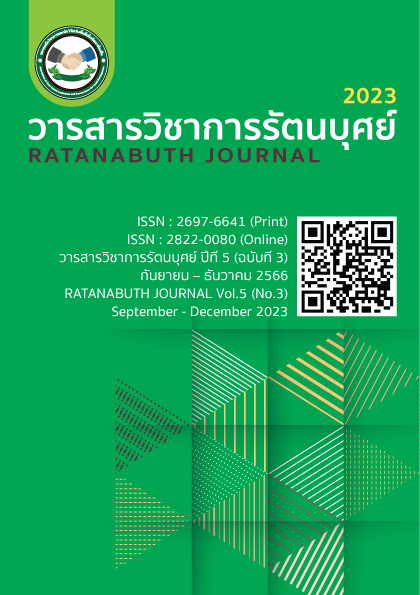Effects of Learning Management According to the Stem Education Approach to Develop Conceptual Understanding and Mental Representation on the Relationships Between Earth, Moon, and Sun for Mathayomsuksa 3 Students Effects of Learning Management According to the Stem Education Approach to Develop Conceptual Understanding and Mental Representation on the Relationships Between Earth, Moon, and Sun for Mathayomsuksa 3 Students
Main Article Content
Abstract
The aim of this research is to compare the results of learning management according to STEM education. In terms of knowledge and Conceptual Understanding on the relationship between the Earth, the Moon and the Sun before class and after class and to compare the results of learning management according to STEM education in terms of student mental representations. On the relationship between the earth, moon and sun after studying with the criteria of 80 percent of Mathayom 3 students, the sample groups are: Mathayom 3/2 students at Prasatwittayakarn School, Prasat District, Surin Province, Semester 1, Academic Year 2023, totaling 35 people. The research tools include: 1) 4 lesson plans 2) 2-way conceptual understanding test, 8 items 3) Study of thinking representatives Statistics used in data analysis are percentage, mean, standard deviation and t - test statistics.
The results of the research found that 1) students who received learning according to STEM education had a higher Conceptual Understanding regarding the relationship between the earth, the moon and the sun after studying than before. Statistically significant at the .05 level. 2) Students who received learning management according to STEM education had a mental representations after learning higher than the criteria of 80%, with statistical significance.
Article Details

This work is licensed under a Creative Commons Attribution-NonCommercial-NoDerivatives 4.0 International License.
References
โชติกุล รินลา, & สายรุ้ง ชาวสุภา. (2562). ผลของการจัดการเรียนการสอนโดยใช้การออกแบบการเรียนรู้จากการสร้างมโนภาพทางเคมีที่มีต่อตัวแทนความคิดทางวิทยาศาสตร์และเจตคติต่อการเรียนรู้เคมีของนักเรียน มัธยมศึกษาตอนปลาย. Journal of Education Studies, 47(Suppl. 2), 68-87.
ศูนย์สะเต็ม ศึกษาแห่งชาติ.(2558). คู่มือเครือข่ายสะเต็มศึกษา.กรุงเทพฯ:สถาบันส่งเสริมการสอน วิทยาศาสตร์และเทคโนโลยี.กรุงเทพฯ: กระทรวงศึกษาธิการ.
สถาบันส่งเสริมการสอนวิทยาศาสตร์และเทคโนโลยี. (2558). คู่มือจัดกิจกรรมสะเต็มศึกษาระดับชั้นมัธยม ศึกษาปี ที่ 1-3. กรุงเทพฯ: องค์การค้าของ สกสค.
สุวิทย์ คงภักดีและเทพพร โลมารักษ์. (2565). การพัฒนามโนมติเรื่อง ฤดูกาลและการเคลื่อนที่ปรากฏของดวงอาทิตย์ของนิสิตครูวิทยาศาสตร์โดยใช้โปรแกรม Stellarium ร่วมกับ Class Action. วารสารวิจัยและพัฒนามหาวิทยาลัยราชภัฏบุรีรัมย์, 17(1), 135-145.
Ausubel, D. P., Novak, J. D., & Hanesian, H. (1978). Educational psychology: A cognitive view. New York: Holt, Rinehart and Winston.
Barnett, M., & Morran, J. (2002). Addressing children's alternative frameworks of the moon's phases and eclipses. International journal of science education, 24(8), 859-879.
Bodner, G., & Orgill, M. (2007). Theoretical frameworks for research in chemistry/science education (pp. 3-27).
Caliskan, S., Selcuk, G.S., & Erol, M. (2010). Effects of the problem solving strategies instruction on the students’ physics problem solving performances and strategy usage. Procedia Social and Behavioral Sciences, 2, 2239-2243.
Cumhur, H. andKasim, N.(2015).Elementary school students’ mental models about formation of seasons: A cross sectional study.Journal of Education and Learning, 5(1), 7-30.
Gilbert, J. K., & Treagust, D. F. (2009). Introduction: Macro, submicro and symbolic representations and the relationship between them: Key models in chemical education. Multiple representations in chemical education, 1-8.
Hallstrom, J., & Schonborn, K. J. (2019). Models and modelling for authentic STEM education: Reinforcing the argument. International Journal of STEM Education, 6(1), 1-10.
Honey, M., Pearson, G., & Schweingruber, H. (2014). STEM Integration in K-12 Education: Status, Prospects, and an Agenda for Research. Retrieved from: https://www.pdfs.semanticscholar.org/bac5/69ca108d7ac7c96574826419074316150060.pdf.
Jansri, S., & Ketpichainarong, W. (2020). Investigating In-Service Science Teachers Conceptions of Astronomy, and Determine the Obstacles in Teaching Astronomy in Thailand. International Journal of Educational Methodology, 6(4), 745-758.
Johnstone, A. H. (1993). The development of chemistry teaching: A changing response to changing demand. Journal of chemical education, 70(9), 701.
Kozma, R., & Russell, J. (2005). Students becoming chemists: Developing representationl competence. Visualization in science education, 121-145.
Prain, V., Tytler, R., & Peterson, S. (2009). Multiple representation in learning about evaporation. International Journal of Science Education, 31(6), 787-808.
Plummer, J. D., Waskoa, K. D., & Slagle, C. (2011). Children learning to explain daily celestial motion: Understanding astronomy across moving frames of reference. International Journal of Science Education, 33(14), 1963–1992.
Vosniadou, S., & Skopeliti, I. (2017). Is it the Earth that turns or the Sun that goes behind the mountains Students’ misconceptions about the day/night cycle after reading a science text. International Journal of Science Education, 39(15), 2027-2051.
Wendell, K.B., & Rogers, C. (2013). Engineering design-based science, science content performance, and science attitudes in elementary school. Journal of Engineering Education, 102(4), 513-540.
Westbrook, S. L., & Marek, E. A. (1992). A cross‐age study of student understanding of the concept of homeostasis. Journal of Research in Science Teaching, 29(1), 51-61.


